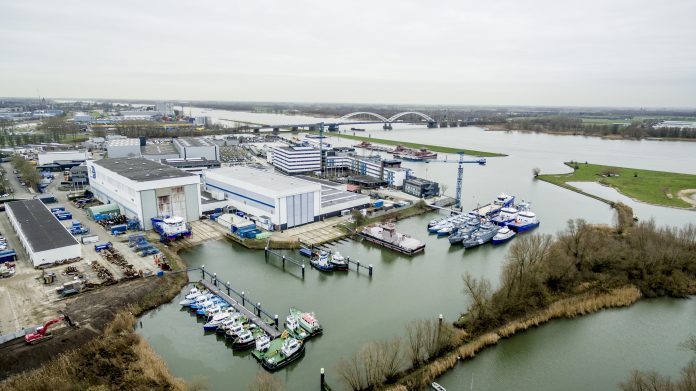Damen Shipyards Group: Our business model is standardisation.
Damen Shipyards Group, headquarted in Gorinchem, The Netherlands, was founded in 1927 by the Damen family. Current owner, Kommer Damen, took over the company in 1969, with a workforce of only ten, and turned it into an internationally operating shipbuilding company with 9000 employees and 33 shipyards worldwide.
 Damen initially grew large with workboats, notably for the dredging industy, with a focus on building in series for stock, says Damen Product Director workboats, Lodewijk van Os. “Kommer Damen saw potential in stock construction when he noticed that contractors needed vessels on short notice. After market research, he started producing standardised workboats on stock.”
Damen initially grew large with workboats, notably for the dredging industy, with a focus on building in series for stock, says Damen Product Director workboats, Lodewijk van Os. “Kommer Damen saw potential in stock construction when he noticed that contractors needed vessels on short notice. After market research, he started producing standardised workboats on stock.”
Efficiency
One of the advantages of standardisation is the versatility it offers, Van Os explains.
“Aquaculture is a growing market, and workboats are used intensively in the aquaculture industry. Because the same work activities take place at each farm, standardised workboats are practical. Also, with a range of modular options available for vessels in the Damen portfolio, standard vessels are easily adapted for other markets, which means good second-hand values, especially given that our workboats have a lifespan of about 30 years.”
Building standardized vessels in series, also means that it already has proven itself, which is good for all aspects of operation, including safety, reliability and efficiency. “Crews and spare parts can be exchanged due to the commonality.”
Damens dredging workboat, the Multi Cat – a big, stable work platform– is frequently used in aquaculture. “The Multi Cat has proven to be especially useful for delousing. This has led us to focus on the aquaculture sector.”
Ship-shaped platform
In 2013, Damen visited AquaNor for the first time, to learn more about the developments in the industry. “Workboats for delousing were in high demand, we discovered, because of  increasing problems with sea lice in Norway. Delousing methods have changed immensely in the past years, so we focussed on this specific subject, in order to equip our workboats better for this purpose. Two years ago we visited several Norwegian companies involved in delousing techniques.”
increasing problems with sea lice in Norway. Delousing methods have changed immensely in the past years, so we focussed on this specific subject, in order to equip our workboats better for this purpose. Two years ago we visited several Norwegian companies involved in delousing techniques.”
Those visits resulted in the development of a new vessel, the UV 4312, says Van Os. “Large deck space is needed for the delousing equipment and pontoons, of which we delivered two for this market, are a good solution. However they have no propulsion, and relocating within a farm or to another farm requires the assistance of a tug. So we developed a ship-shaped platform as a solution for the aquaculture industry, with a bow for good seakeeping and own propulsion that offers excellent manoeuvrability. It can accommodate delousing equipment, but is also suitable for other kinds of work, with its large work deck and accommodation for workers. It’s the first time a ship like this has been built outside of Norway.
“Norway is the technological leader, but aquaculture is global, and our ships can be found everywhere in the world. As a result of this, we know the impact different climates have on our vessel. We can use those experiences in shipbuilding for aquaculture anywhere.. And our network for service and sales is already global.”
Construction kits
Another option that Damen provides is construction kits. “Those can be of interest for local shipbuilding industries. We are also focussing on countries such as Canada, the United Kingdom, Tasmania and Chile. By visiting those countries, you notice differences you can respond to, like the size or scale of a farm, cost structure and the distance to market. In Chile, the required workboats will be different than, for example, for Norwegian farms. Our diverse portfolio allows us to adapt to those different markets.”
 As the offshore oil and gas business decreases all over Europe, shipbuilders’ eyes are on the aquaculture industry, says Van Os. “We all look for alternatives, and aquaculture is booming resulting in more demand in workboats. So we are all each other’s competitors. Everybody is out there to get a piece of the pie.”
As the offshore oil and gas business decreases all over Europe, shipbuilders’ eyes are on the aquaculture industry, says Van Os. “We all look for alternatives, and aquaculture is booming resulting in more demand in workboats. So we are all each other’s competitors. Everybody is out there to get a piece of the pie.”
Damen is ready to face the competition, he adds. “We are in constant communication with the market. We recently delivered a new Multi Cat 2409 to a Scottish farmer. We also developed a small workboat of 15 metres, that we will launch very soon. A 43m long Utility Vessel, the UV 4312, is currently under construction. It will be ready in March, 2018. And when it’s handed over to its new owner in Norway, I am sure it will lead to even more interest. Companies will, of course, want to see it in action first.”
Aquaculture is still a small part of Damens portfolio, but Van Os expects it to grow in the years to come. “We expect it to become a stable, successful market, both in and outside Europe.”

